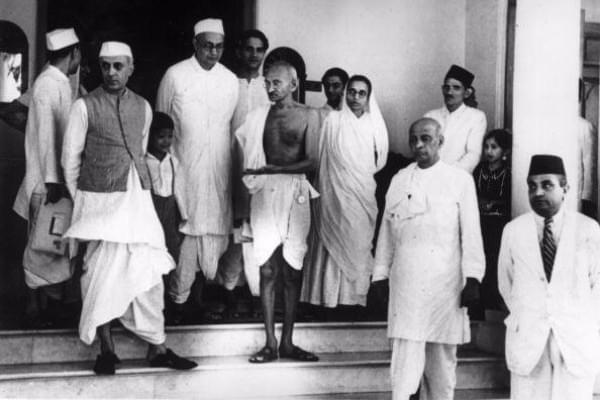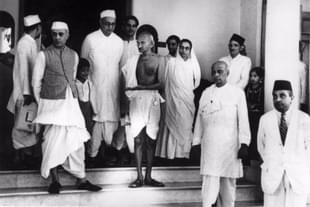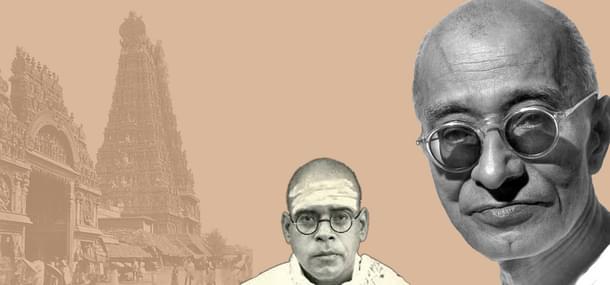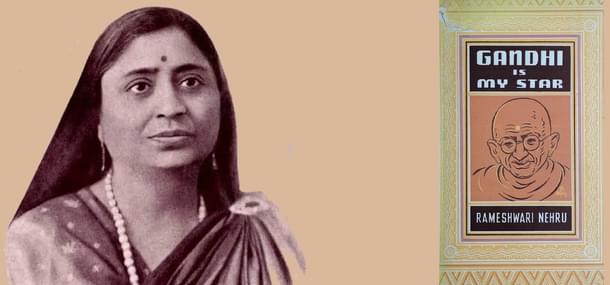Politics
The Continuing Relevance Of Gandhi's 'Temple Entry Movement' For Independent India
Aravindan Neelakandan
Oct 02, 2024, 07:33 PM | Updated 07:33 PM IST
Save & read from anywhere!
Bookmark stories for easy access on any device or the Swarajya app.


It was an important meeting of the Rashtriya Swayamsevak Sangh (RSS). The task at hand was the finalisation of the ‘Unity Hymn’ (Ekatmata Stotra). The atmosphere had become tense with respect to one particular name - Mahatma Gandhi.
For many within the Sangh, Gandhi symbolised appeasement, which led to the tragic partition of India. The horrors of Partition were fresh wounds, and Gandhi was the reason.
There were equally strong other voices urging a broader perspective. Gandhiji should not be solely defined by this contentious aspect of his legacy.
Then there was Umakant Keshav Apte, affectionately known as Babasaheb Apte. Rising to speak, Apte highlighted Gandhi’s significant contributions to Sanatana Dharma. Then he said that even Gandhi’s perceived appeasement stemmed from his deep conviction in the strength of Hindu Dharma.
A profound silence followed Apte’s words. All eyes turned to ‘Guruji’ Golwalkar, the second all-India leader of the RSS, whose decision would be final.
After a moment of contemplation, Golwalkar broke the silence, expressing his complete agreement with Apte.
Since then, every morning, countless RSS cadres reverently chant the names of Mahatma Gandhi along with Ramana Maharishi as presented in the 29th verse of Unity Hymn their mandatory morning prayer.
In today’s Hindu ‘Right,’ bashing Gandhi has become a veritable rite of passage to be hailed as a Hindu saviour. Yet the modern triumphs of Hindutva, especially the Ram temple at Ayodhya, are built on the painstaking efforts of Gandhi and his followers, a list that today includes our current Prime Minister.

Gandhi spearheaded a nationwide campaign for temple entry, championing the rights of marginalised ‘Harijans’ during the freedom struggle.
Supported by Arya Samaj and Hindu Mahasabha, the movement faced internal dissent from orthodox Congress members. (The Hindu Mahasabha would later distance itself from Gandhi though).
Gandhi’s dedicated disciples tirelessly strategised to achieve temple entry. The orthodox Hindu sections used various arguments, from outright hatred to pseudo-scientific and pseudo-spiritual justifications, to oppose ‘Harijans’ entry. Meanwhile, the British played their own mischief.
C Rajagopalachari, a key lieutenant of Gandhi, tirelessly campaigned across India for ‘Harijan’ temple entry, going door to door. Gandhi believed that while legislative measures were necessary to combat this discrimination, true change required a voluntary transformation of hearts.
Legal victories for temple entry were challenging, but changing the mindset of caste Hindus was even more arduous. Some Harijan leaders expressed disinterest in temple entry, a sentiment that should have alarmed non-Scheduled Community (SC) Hindus, indicating an emotional drift from Hinduism. Instead, it pleased them, revealing a deep-seated perversion. They argued that SC Hindus themselves did not want temple entry.
Radicals within Congress, like Jawaharlal Nehru, initially viewed temple entry as a distraction from the independence struggle. Meanwhile, the British subtly and overtly supported the orthodoxy against temple entry movement. They feared that successful temple entry for Harijans would emotionally bind them to the freedom movement and undermine the British narrative that Hindus were unfit to govern justly.
A nationwide success in temple entry would dismantle this myth of the Empire’s civilizing mission.
Initially skeptical of Gandhian efforts for temple entry, Jawaharlal Nehru eventually recognised the British strategy at play.
The context was a bill introduced by C.S.Ranga Iyer which sought the removal of disabilities that the ‘Untouchables’ suffered – that included non-entry into Hindu temples. The British, foreseeing the socio-emotional unity this bill could foster among Hindus, sought to sabotage it without dirtying their hands. They cunningly shifted the blame onto traditionalist Hindu opposition. Predictably, caste-Hindus and traditionalist leaders unwittingly became the British’s ‘useful idiots.’
In his Autobiography, Nehru astutely exposed this insidious British tactic:
And then the remarkable spectacle was witnessed of an outstanding leader of the Congress going from house to house in Delhi, visiting the members of the Assembly and canvassing for their votes for this Temple Entry Bill. Gandhiji himself sent an appeal through him to the Assembly members. And yet civil disobedience was still going on and people were going to prison, and the Assembly had been boycotted by the Congress and all our members had withdrawn from it.... I was amazed at Gandhiji's appeal, under the circumstances then existing, and even more so by the strenuous efforts of Rajagopalachariar, who, a few weeks before, had been the acting President of the Congress.... The Government attitude to this Temple Entry Bill, then and subsequently, was very revealing. It put every possible difficulty in the way of its promoters, went on postponing it and encouraging opposition to it, and then finally declared its own opposition to it, and killed it. That, to a greater or lesser extent, has been its attitude to all measures of social reform in India, and on the plea of non-interference with religion, it has prevented social progress. But this, it need hardly be said, has not prevented it from criticising our social evils and encouraging others to do so.Jawaharlal Nehru, An Autobiography, Oxford University Press, 1936:1942/1982, pp.381-2
The social justice narrative in independent India suggests that social justice in India owes its existence to British rule. The above passage by Nehru shows how this perception is far from truth.
It is essential to remember that Gandhi’s approach to civil disobedience and passive resistance was profoundly shaped by the Vaishnava movements.
His journey to transcend caste biases and racial prejudices was deeply rooted in the spiritual egalitarianism of Advaita Vedanta, leading him to the profound truth of the oneness of all existence, beginning with the unity of humanity.
The temple entry movement stands as a testament to the true Vedanta of Sri Narayana Guru. Inspired by Sri Guru’s Advaitic principles, Gandhi championed the cause of temple entry for all. Today, the hollow pretensions of pseudo-Advaita, which merely pay lip service to Advaita while perpetuating institutionalised discrimination, have rightfully been consigned to the dustbin of history or a small circle of motley upper-castes.
Imagine, for a moment, that we had gained independence without the powerful movements to abolish untouchability and ensure temple entry for all. What would our reality be? We would still be entangled in debates over the so-called ‘science of untouchability.’ Right-wing factions would publish books on ‘Untouchability Vidya,’ justifying the exclusion of fellow Hindus from temples with absurd pseudo-scientific claims about jatis having unique frequencies and wavelengths, auras and what not.
Hindu society would have been weakened to such an extent that the Ayodhya movement would be reduced to a mere legal battle, fought by lawyers and petitions rather than driven by the people’s passion and sacrifice. Why should I care for a temple in which I cannot enter? Conversions would have surged, and today, Hindus might have been a minority in even more regions of India.
But for the pre-independence temple entry movement, reclaiming and rebuilding of the Ayodhya temple in independent India would have likely been impossible.
When Rajaji secured temple entry in Madurai through a blend of mass movement and legislative strategy, Gandhi sent Rameshwari Nehru, then vice-president of the All India Harijan Sevak Sangh, to join the cause.

She made a profound observation: it was the embodiment of Hindu ideals that forged a powerful democratic force against injustice. These ideals resonated deeply with the people, stirring them to action. Despite being a staunch Gandhian, she recognized and highlighted this crucial aspect.
Out of this episode emerges two striking facts. One is the demonstration of the power of the combined will of the common people which is the only sanction behind all human concerns, and the other, the possibility of the Hindu ideals supplying to the world the secret of making democracy effective.... Mahatma Gandhi, Rajagopalacharya, Dr. Rajan, Vaidnath Iyer and others no doubt laboured hard but their labours would have been set at naught if they did not find favour with the people.'Gandhi is my Star', p.128, 1950
Gandhi tapped into Hindu traditions to combat social stagnation within Hindu society. He personally confronted these issues within him also. In this battle he consistently drew his strength from Hindu sources. For the Gandhian movement, eliminating untouchability was not a defeat of Hinduism but a Hindu triumph, serving as a model for fighting injustice globally.
The Hindu movement has ceded this crucial ground to anti-Hindu forces in independent India, a historical tragedy with potentially devastating consequences for the Hindu future.
In striving for holistic and sustained Hindu unity and ensuring that Hindu society remains true to its core ideals, Gandhi is even more relevant today for the Hindu movement. Criticise him by all means but learn also from his Dharmic contributions.





